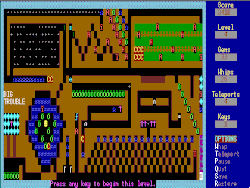Kingdom of Kroz
| Kroz | |
|---|---|

Screenshot of game
|
|
| Developer(s) | Scott Miller |
| Publisher(s) | Apogee Software |
| Designer(s) | Scott Miller |
| Platform(s) | MS-DOS |
| Release | 1987 |
| Genre(s) | Maze |
| Mode(s) | Single-player |
The Kroz series is a series of video games created by Scott Miller. The first episode in the series, Kingdom of Kroz, was released in 1987 as Apogee Software's first game. It was also published on Big Blue Disk #20. The story of the game places the player as an archeologist searching for the priceless Magical Amulet of Kroz in the mystical Kingdom of Kroz. The object of the game is to survive numerous levels of attacking monsters.
The player character collects gems as they go; each time a monster touches them, they lose a gem and the monster dies. The character's main defense consists of whips which can be used to kill monsters and destroy certain walls; however, each whip can only be used once. Some levels are generated randomly; these tend to be rather chaotic, and essentially consist of a mad dash through waves of attacking enemies to pick up valuable objects and/or escape to the stairway. A major part of the game is careful conservation of gems and whips; sometimes it is better to allow an enemy to take a gem rather than use valuable whips that will be needed to break down walls blocking the exit.
The Kroz games were inspired by an earlier dungeon crawling game, Rogue. Scott Miller tried to create a game that had some of the elements of Rogue, but with less randomness and more reliance on the abilities of the player than on luck. Miller, fond of including backwards words in his games, came up with the name by spelling Zork backwards.
The original Kingdom of Kroz game took top honors in the game category in a programming contest in 1988, and came out number two overall.
The game was implemented entirely in the text mode of the PC, using various characters in the computer's character set, as well as different colors, to present a "graphical" environment. This is not quite ASCII art, because it used the proprietary graphical characters of the IBM PC character set as well as standard ASCII characters, and also depended on the setting of foreground and background colors for individual characters; such a combination was sometimes termed ANSI art, but that is a misnomer in this case because the ANSI escape sequences were not used.
...
Wikipedia
